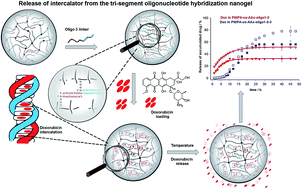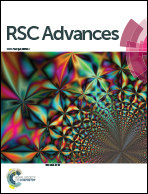Environmentally sensitive nanohydrogels decorated with a three-strand oligonucleotide helix for controlled loading and prolonged release of intercalators†
Abstract
Two different short DNA strands were attached to the surface of a gel nanoparticle. The third DNA strand that was 50 : 50 complementary to those strands allowed the formation of a three-strand hybrid. The gel nanoparticles were synthetized from N-isopropyloacrylamide (NIPA), N,N′-methylenebisacrylamide (BIS) and acrylic acid (AA) by employing the free radical polymerization reaction. The physicochemical parameters of this novel nanogel stimulated its penetration of selected cancer tissues (Hela and Insulinoma cells) and allowed effective delivery of the anticancer drug doxorubicin (Dox). Since the three-strand oligonucleotide hybrid sites were located at the surface of the nanogel, this allowed effective storing of Dox by its intercalation to the double stranded DNA. The binding through intercalation resulted in prolonged release of the drug. The release of Dox at selected temperatures was a consequence of oligo1-2-3 hybrid conformational change, the shrinking of the hydrogel and zeta-potential change.


 Please wait while we load your content...
Please wait while we load your content...